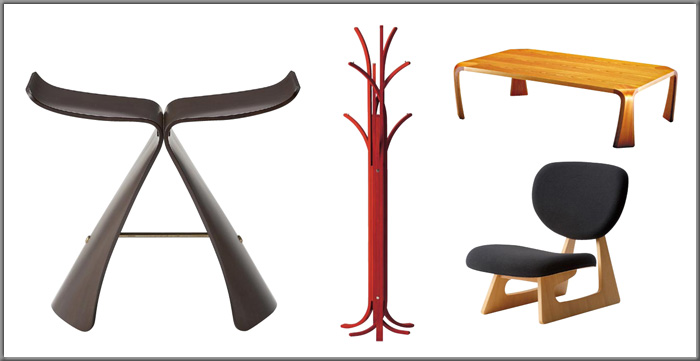Home > Highlighting JAPAN > Highlighting Japan NOVEMBER 2012 > Behind the Brand
Highlighting JAPAN
COVER STORY: Japanese by Design
Behind the Brand
Japan's pop culture, fashion, and modern art have been all the rage overseas in recent years. While they are cutting-edge, they also embody traditional culture and hand-crafted techniques that are quintessentially Japanese. Toshio Matsubara introduces new designs borne of
traditional Japanese culture in the fields of fashion and furniture.
Furniture Masterpieces
Tendo Co., which operates its factory in the city of Tendo City in Yamagata prefecture in the Tohoku region, is a furniture manufacturer that has received high praise from around the world because of its innovative design and stunning finishes. Its furniture has been supplied to the Imperial Household as well as to a number of government agencies, public facilities, and luxury hotels, with the company receiving numerous awards at overseas exhibitions. The foundation of this furniture-making is a collaboration between the company's superb curved plywood technique and first-rate designers.
Curved plywood is created by using a wood-processing technique that glues super-thin sheets of natural wood that are around 1 mm thick with a bonding agent, pressing them in a mold and finally heat molding them with electricity.
There is greater freedom in manipulating plywood for design as this technique can create complex molds that are not possible to form with solid wood.
Tendo was established as a union of woodwork craftsmen in 1940 to manufacture munitions, such as ammunition chests, and it poured all its energy into completing the curved plywood technique immediately after the war. And then in 1947 it became the first private company to adopt a high-frequency heat molding device in Japan and was ahead of the pack in starting to use curved plywood for practical purposes.
This new technique caught the attention of Sori Yanagi, who later became Japan's leading designer. This is because complex designs, which were not possible with existing methods, became a reality using curved plywood. A furniture-making project that Yanagi called to start, came to fruition in the form of Butterfly Stool in 1956. Butterfly Stool was awarded the gold medal at La Triennale di Milano in 1957 and in the following year in 1958, became part of the permanent collection of the Museum of Modern Art in New York, which in turn widely spread Tendo's name within the furniture industry around the world.
This type of collaboration with first-rate designers continued to flourish in an organic manner in Japan. Top-notch architects and designers successively started to collaborate with Tendo, as seen in the spectators' seats in the Yoyogi National Stadium (1964/design: Kenzo Tange); furniture in the Akasaka Palace (1974/design: Yoshiro Taniguchi) and furniture in the National Bunraku Theatre (1984/design: Kisho Kurokawa). This trend was further spurred on by the possibility of even more complex plywood forms when the company developed its own microwave heat molding device in 1975.
Tendo is currently signed on with nearly 100 outside designers, including architectural firms, and half of almost 600 of its products are created from collaboration with them.
Naturally, the skills of a seasoned craftsman are also indispensable in furniture-making. Materials made from lumber can differ in color, grain, and strength even if they are from the same species. Craftsmen at Tendo carefully select each piece of wood so that the products are finished in a uniform tone. Further, since the processing itself is done meticulously in order to match the characteristics of the wood used, most of the steps are completed manually.
Furniture pieces that have been created in this manner also attract much attention overseas, but since furniture prices end up rising several fold due to extremely high shipping costs for furniture, Tendo sells just a few overseas. Still, people who need to have its furniture apparently end up placing an order on their own from overseas.
The beauty of Tendo's furniture, which is exemplified by its delicate curves and forms, can only come into being with a union of the molded plywood technique that has developed over sixty years and an artisan's steadfast devotion to handcrafts.
Caption (From left):
Butterfly Stool
The designer of Butterfly Stool is Japan's leading industrial designer Sori Yanagi, who incorporated beautiful curves, which are unique to curved plywood, into the design. Its structure is simple: two molded plywood sheets are held together with two screws and a brass stretcher below the seat. The unique form appears like a butterfly taking flight in the air. While over half a century has gone by since it went on sale, Butterfly Stool remains highly treasured to this day.
ALBERO coat stand
This coat stand, designed with the image of trees in a forest, was commercialized in 2006 as part of the Yamagata Carrozzeria Project aimed at revitalizing industries in Yamagata Prefecture. It was a winner of the 2006 Good Design award.
The designer of the coat stand is Ken Okuyama, who became an independent industrial designer after working for GM and Porsche, and after serving as a director for Pininfarina. The coat stand employs an extremely innovative structure consisting of a total of nine poles — three each of three types of curved plywood — that are combined together to support each other. It is a unique object that is geometric yet conveys a sense of warmth inherent in wood.
Zataku
This is a masterpiece among low tables that has been popular since it was first sold in 1959. The table received the G mark Long Life Special Award, which recognized the sale of hundreds of thousands of the item. The table is primarily used in hotels and Japanese inns, but is also widely popular in regular households, and has even come to be known as a staple in a traditional Japanese room.
The designer of this low table is Saburo Inui, known as the Tendo in-house technician who developed the microwave heat molding device. The structure of the table is simple yet stunning, as it does not have sharp corners and its legs curve slightly inward. Its sides are flat, so the table can be placed straight up on its side. The table is popular also because it is made out of only a few components and it is light enough for a woman to easily handle.
Low zaisu chair
This chair was designed when a residence was being planned for a kabuki actor. The request was to design a chair for a traditional Japanese room that would enable the actor's aging mother to sit without burdening her legs. The chair, which has been quite popular since it went on sale in 1960, was designed by Daisaku Cho of Sakakura Associates. It received the Good Design Award in 1964.
The seat height is 29 cm, so one can sit on it with legs outstretched, but it still allows one to sit cross-legged as the seat area is wide. The feet of the chair are moderately wide and curved so that they do not damage tatami mats and carpet. The portion for the cushion is constructed with a soft and rounded design, which is suitable for traditional Japanese rooms, of course, but also for western-style rooms with wood flooring or carpeting.
Credit: COURTESY OF TENDO
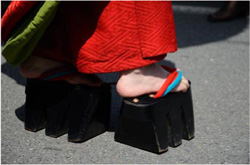
High-heeled geta sandals as worn by the oiran of the Edo period
A Pair of Shoes in the Global Spotlight
Singer Lady Gaga's fashion, because of its unconventional style, is frequently covered positively by the world's media. A part of her collection is her favorite pair of heel-less shoes, which are now all the rage in the world of fashion, but also in the art world. These shoes were created by up-and-coming designer Noritaka Tatehana.
With encouragement from his mother, a teacher of the art of making dolls, Tatehana started to attend a preparatory art school in his first year of high school with the aim of getting into an art university. He initially wanted to become a painter, but having been deeply affected by a magazine article on fashion designer Martin Margiela, he decided to pursue a career in fashion. He created his first pair of shoes when he was fifteen years old, and started to visit brand-name stores in the fashionable neighborhood of Aoyama in Tokyo every weekend in order to promote himself.
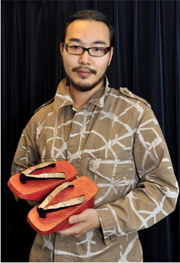
Noritaka Tatehana holds the pokkuri sandals he designed.
Credit: YOSHIFUSA HASHIZUME
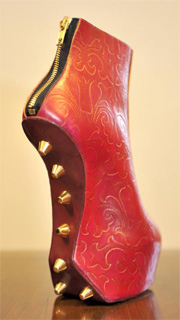
Credit: YOSHIFUSA HASHIZUME
Immediately upon graduating, Tatehana established his own brand NORITAKA TATEHANA, and took on the world. He was bombarded with orders for the shoes, mostly from the United States and Europe, but also from other countries, and his 2010–11 fall-winter collection was chosen to be part of the permanent collection at the Museum at FIT (Fashion Institute of Technology). The circular geta sandals, which were among the items in his graduation project, are part of the permanent collection at the Victoria and Albert Museum in the United Kingdom. The shoes, which are completely hand-made beginning with the leather dyeing, sell for 400,000 yen to 1,500,000 yen a pair. Lady Gaga ended up ordering a total of twenty-five pairs. Tatehana apparently met her briefly, and it could be said that the number of pairs she ordered reveals her satisfaction with the shoes.
While pursuing a number of different projects, including visual direction for musicians, commercial direction, and a leading role in a project aimed at giving traditional Japanese crafts an international profile, Tatehana will outsource the manufacturing of his shoes to Italy in 2013 and launch a prêt-à-porter collection. He eagerly awaits his next opportunity to create and sell a new type of clothing that incorporates the beauty of traditional Japan.
"It just so happens that I started that way and I don't see myself as operating a brand of shoes. The important thing is how one creates the 'real thing.' I am confident," says Tatehana.
Aesthetic Accessories in Everyday Life
Japanese people have traditionally incorporated their aesthetic sense into their everyday accessories and treated them with sentimental attachment. Here are three modern Japanese accessories that reflect the Japanese sensibility.
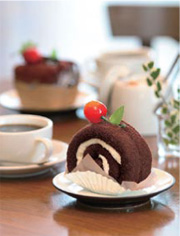
The Le Patissier chocolate roll cake is made out of a towel, but you can't tell it apart from a real cake at a glance. You can unfold it to use as a regular towel. They are now being sold in about ten countries and regions, including Asia, Europe and the United States.
Credit: COURTESY OF PRAIRIEDOG CO., LTD
A bit of a fun surprise comes with this popular gift: a cake made out of a towel that is shaped so well it is hard to tell it apart from a real cake at first glance. This "cake towel" is made by simply folding and rolling an ordinary towel, which is then packaged in a paper tray and cellophane, just like that used to gift-wrap a real cake. The Le Patissier series produced by Prairiedog Co., features these products, in which soft colored towels resemble real sponge cake and cream. These are created by focusing on each tiny detail to make them look real and appetizing. When looking at these cake towels, people visiting exhibitions and stores will enthusiastically exclaim, "That looks delicious!" Quite a few people even mistake the products displayed in the cases as real cakes. After enjoying them as a room decoration, they can later be used as regular towels. Even the cherry placed on top of the cake towel is really a magnet.

With this mojibakeru, the kanji character for lion, 獅, can be transformed into the animal.
Credit: COURTESY OF BANDAI CO., LTD.
Popular among children is the toy that sometimes comes with the purchase of packaged sweets, or the shoku-gan ("shoku" means food and "gan" means toy. Mojibakeru, which can literally be translated as "transforming characters," looks like a 5-cm-high kanji character shaped toy). A kanji character can be broken into several parts and reassembled to form the animal figure the original kanji character represents. For example, the kanji character 猫, which means "cat," can be transformed into a cute cat. Another one changes shape from the kanji character 蟹, meaning "crab," to a crab with two big claws. "Mojibakeru" is a term that was coined by combining moji, meaning "character," and bakeru, meaning, "To take the shape of." This product is manufactured by BANDAI Co., and thirty different types of kanji characters are available. The shapes of the various parts comprising the original kanji characters are designed to allow each animal to be well portrayed by highlighting its particular look and characteristics.
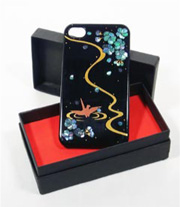
A gold, Echizen-lacquered smartphone case titled "Tsuru to Raden (Crane and Mother-of-Pearl Inlay)." The Echizen-lacquered smartphone cases can be bought online from six countries including Europe and the United States.
Credit: COURTESY OF PRINCIPLE CO.,LTD.
A special smartphone case
Mobile phones and smartphones (multi-function phones) are must-have high-tech devices for people in the modern age. In Japan, mobile phone and smartphone cases employing one of the country's traditional arts, lacquerwork, have come onto the market. One of these products, rendered in gold or silver Echizen lacquer, was just released in July of this year. Echizen lacquer is a traditional Japanese art craft of Fukui Prefecture. Each one of these smartphone cases, inlaid with mother-of-pearl set beneath shells and other glittering, elegant ornaments, is handcrafted by skilled craftsmen and decorated with a sprinkle of metal or colored powder. One competition solicited free designs from artists, which were then voted on by foreign citizens. These high-quality smartphone cases, coproduced by Echizen-shikki Co. and Principle Co., blend the new sensibility of Japanese designers with the manufacturing techniques of Japanese craftsmen. Twelve different kinds of iPhone case designs are currently available, including a crane, cherry blossom, fan, and rock garden.
© 2009 Cabinet Office, Government of Japan
